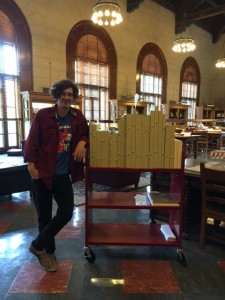
Back in 2014, Stephanie Phillips interviewed APL’s interim Architecture and Planning Librarian, Katie Pierce Meyer, who has since accepted the permanent position at APL as the Humanities Librarian for Architecture and Planning. We have not shone the spotlight on anyone else since, and we decided it was time to recognize the amazing work Tony Tomasello does by caring for APL’s physical collection!
Tony is our local book preservation technician, working in conjunction with Wendy Martin’s team at PCL in Preservation and Digital Curation Services. As a preservation technician, he works 19 hours for UTL. He explains rather modestly the nature of his job:
Ah well, [my role is] the same as everyone’s at the libraries I suppose. Just to see to it that the collection material here is made available to anyone who needs it now and into the future. So more particular just make sure the books are in good shape and can be read without risking its availability for future patrons.
He continues discussing the day to day of his job:
I pretty much just do it – the ones that need the most repair, I give my fullest attention so I pretty much just fix them as they come in. I do the most severe ones first or if someone just really needs the book, you know, if it’s in rough shape I’ll do that one really quickly. Special Collections materials, I can say are my highest priority. They’re the most fragile. They’re the ones that are most at risk for long term use, and they’re probably our most valuable materials as well.*
His interest in preservation stems from his love of the relics and experiences of the past – the connections made through the experience of the books themselves. Tony explains:
I guess it starts from my character. I have always had a fondness for old things – old music, old furniture, old books, old ways of doing things, riding bicycles instead of driving cars, looking nostalgically back on trains.
While Tony had worked for the library for several years prior to assuming his current role, he jumped at the chance to become our local preservation technician when the position opened. He was initially trained by his predecessor, Lorrie Dong – a Ph.D. graduate from School of Information at UT. When asked how he developed his expertise, Tony notes:
I had excellent teachers. First Lorrie who trained me before she left. She just taught me all the basics, the procedures I still do the most often which are rebacks, end paper replacements, and tip-ins for pages that have come loose or need to be replaced, and doing minor repairs on tears and things like that. Then I got help from the larger preservation department, and they taught me even more procedures like how to make custom housing for books that we’re really not allowed to repair without ruining their value in someway.
Tony also taught himself other skills that he needs to tend to the collection –
Then there are things I picked up on my own – I watched YouTube videos to learn how to sew. The rest of it is doing it, doing as many repairs as I can everyday I’m here.
When asked about his favorite aspect of the work, Tony explains:
Apart from getting my hands on some really old, rare books from time to time, there are certain satisfactions from the job…like being able to work slowly, take my time in a world that mostly rewards speed. I get to take my time and really care for what’s in front of me. And then there’s a certain satisfaction in the math, just measuring things, drawing straight lines. I think there must be something but not really close to the satisfaction that Kepler must have had when he looked up at the sky and saw that the celestial bodies were moving in a way that his math predicted. I get the same satisfaction when I measure out a new case and find that it fits the books.
In his final thoughts, it was evident that conservation and preservation are less a job and more a calling. He concludes:
I have some vague philosophical ideas about the importance of my work – just about maintaining enduring objects that are the basis of our culture that are ignored by the larger part of the populous. I think it’s important to have little monuments – like little physical reminders of the past. I’m glad that I get to have some part in maintaining those objects. He continues: It would be horrible to loose the paper, the board, and the glue, and the sewing, and the little mementos of past people’s work.
*I asked Dan Orozco to comment upon all the work Tony does for APL, knowing that his contributions are wide ranging. Dan writes of Tony’s work:
It has truly been awe inspiring to see the growth of Tony’s knowledge and abilities at doing book repair. I was very alarmed at the demise of the Kilgarlin Program at the iSchool. We had an impressive run of conservators come through to practice their craft in this position. My fear abated when I saw the skill with which Tony takes care of our Special Collections materials. He also does our pest monitoring and dehumidifiers in Special Collections – very important in a 105 year old building.
If this wasn’t enough, Tony can also provide back up for every position at Architecture. He can create reserve lists, undertake ILS scanning, and he knows our collection as well if not better than most. Recently, Tony created lists in Sierra to oversee a massive weeding project to free up about 300 linear feet in the stacks of the circulating collection. He has also been here to help with extra events in our reading room, from symposiums to filming chancellor McRaven’s interview to hosting first lady Laura Bush. This young man can truly do it all.

